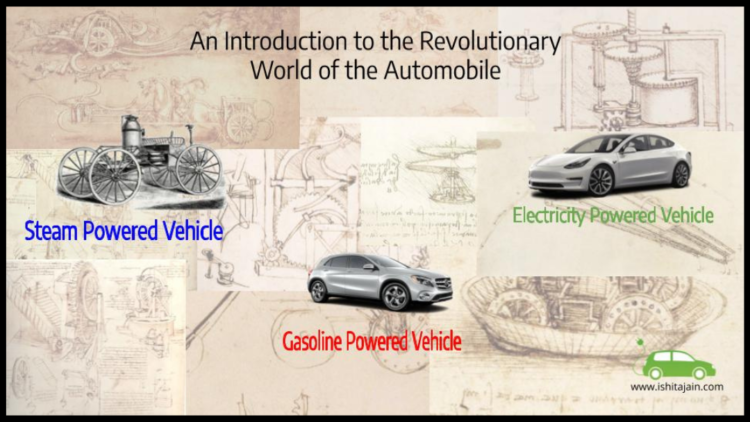Electrical Vehicles Series (Part 3)
Imagine a planet without any pollution. Where the air is forever fresh, and the water as clear as glass. The typical Earth. An utopia. But is it possible? Is it possible to even imagine it? Or is this planet too corrupt? Even more, is it possible to turn the thought into a reality? Maybe… step by step. In order to address this catastrophe, we will take a look at one of the many causes of anthropogenic pollution – the automobile.
Let’s take a look into the evolving history of automobiles. Since the 17th century, the development of cars has advanced to incredible stages, starting with the preliminary sketches by Leonardo Da Vinci, depicting something with wheels and complex mechanisms – a machine that would allow people to easily transport themselves. Automobiles have since been separated into three main powering styles – the steam engine, the gasoline engine and the electric motor. This brings up the question, how have these cars evolved? In 1769, French engineer, Nicolas Joseph Cugnot created the first steam-powered vehicle. Later, around 1832 – 1839, Scottish engineer Robert Anderson created the first ever electric carriage. This marks the first rudimentary electric car, though many improvements have been made over the years. However, electric cars didn’t earn as much popularity as it’s counterparts. People were more inclined towards internal combustion engines (ICEs) when it came to buying a car. An ICE is classified as an engine powered by gasoline. The first fully functional internal combustion engine in the world was created by German engineer, Karl Benz in 1885 – 1886. Although several automobile inventions had been created before this moment, many people refer to this as the first true car. Karl Benz is most famous for having invented the car brand Mercedes-Benz. Shortly afterwards, in 1886, two other German engineers, Gottlieb Wilhelm Daimler and Wilhelm Maybach, created the first four-wheeled gasoline-powered engine, leading the way for American engineer George Baldwin Selden to create the first combined internal combustion engine which was developed between the years 1876 and 1895. Coming to the end of the timeline, American engineer brothers Charles Edgar Duryea and Frank Duryea constructed the first successful gas car with a two-stroke motor in 1893. Today, most of the world uses ICE cars. This is a big problem as the environmental consequences of this are extremely hazardous. But how could something so small, like driving these cars have such a large impact on the population?
Gasoline run cars are extremely dangerous to the environment. There are so many issues these machines present. ICE cars produce two chemicals through the exhaust pipes; nitrogen oxide (NOx) and volatile organic compounds (VOCs). When NOx and VOCs mix together in sunlight, they create ozone in the troposphere (the layer of atmosphere closest to the ground). Ozone is a greenhouse gas and secondary pollutant, as well as one of the main ingredients in smog. It is so powerful that it damages the tissues in both plants and animals. By reducing consumer use of gasoline vehicles, the amount of ozone in the atmosphere scales down, and not only that, but it cuts down on another byproduct of NOx, which is acid rain. It is polluting the already-limited sources of freshwater. Moving on, gasoline powered cars burn fossil fuels, and in that process, unleashes tons of carbon dioxide into the atmosphere. The carbon dioxide (CO2) works like a blanket over the atmosphere that traps the heat inside of the Earth. This is one of the biggest contributors to global warming. Too much CO2 in the atmosphere can lead to conditions similar to that of the planet Venus, which is surrounded by clouds of sulphuric acids that trap heat from the sun, keeping the planet’s temperature unbearably hot. Even though Mercury is closest to the sun, Venus is hotter. The fact that most of the world population excessively uses these cars is quite terrifying for the lives of all biotic elements.
In order to survive, humans need the planet to survive. But with the pollution engulfing the air and sea, it feels as though one has to struggle to breathe. Countless solutions have been made to help deal with this crisis. One of the biggest resolutions are the newly popular electric cars (EVs). These machines are energy efficient and don’t pollute the environment as they don’t burn fossil fuels to operate. Studies have shown that these vehicles are also more cost-efficient in comparison to ICE cars in the long run. While the upfront cost for an EV (electric vehicle) is more than that of an ICE vehicle, considering the cost of gasoline and consistent engine maintenance and repairs required for ICE vehicles over the years, the EV turns out to be a better investment. Even though EV’s are presenting themselves as the solution to the ecological dilemmas that are being faced today, there’s still one mega conundrum that many people tend to overlook. And it all comes down to the very thing that powers all the electric vehicles – the batteries. These batteries last for a few years and then they need to be replaced.
Looking into the future, several years from now, what happens when the batteries in electric cars die? How can one dispose of these batteries? This may not seem very big at first, but it can actually cause some serious problems in terms of the environment and the health and safety of the global population. In order to solve the major dilemma under everyone’s noses, future articles in this series will probe into this steadily increasing problem in more depth. This will include an overview into the different parts of an electric car battery, a look at current solutions that are in progress to fix the issue, and will be exploring various EV companies, in order to get a better understanding of the situation. How far can civilization push themselves to keep this beautiful planet safe?


